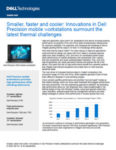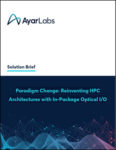In this sponsored post, Matthew Ziegler at Lenovo discusses today’s metric for raw speed of compute. Much like racing cars, servers do “time trials” to gauge their performance relative to a given workload. There are more Spec or Web benchmarks out there for servers than there are racetracks and drag strips. Perhaps the most important measure is the raw calculating throughput that a system delivers: FLOPS, or Floating-Point Operations Per Second.
Smaller, faster and cooler: Innovations in Dell Precision mobile workstations surmount the latest thermal challenges
This white paper describes that with the latest Precision models, Dell continues to pioneer smarter thermals for mobile workstations that allow processor and GPU innovations to evolve so you can be more productive. To get the peak performance your demanding workloads require in easily portable sizes, Dell Technologies has Precision mobile workstations that best meets your needs.
Paradigm Change: Reinventing HPC Architectures with In-Package Optical I/O
In this white paper, our friends over at Ayar Labs discuss an important paradigm change: reinventing HPC architectures with in-package optical I/O. The introduction of in-package optical I/O technology helps HPC centers accelerate the slope of compute progress needed to tackle ever-growing scientific problem sizes and HPC/AI convergence. Ayar Labs expects to not only see its technology extend the traditional type of architecture to put the HPC industry back on track, but also result in an inflection point that fundamentally changes the slope of the compute performance efficiency curve. The key will be enabling converged HPC/AI centers to build systems with disaggregated CPUs, GPUs, FPGAs and custom ASICs interconnected on equal footing.











